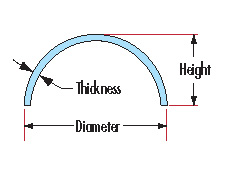Why is the yellowing of aluminum aluminum products after cleaning?
Dome lenses are hemispheres. The two optical surfaces are an equal thickness apart, creating a naturally strong shape that gets tougher under pressure. This makes dome windows ideal for underwater environments and in applications such as camera dome ports and submersible windows.
Sapphire domes: For infrared applications we can provide sapphire domes. Sapphire is an extremely hard material with transmission of over 80% in the 2-5µm wavelength range. As with fused silica, sapphire is able to withstand extreme pressures, making it the perfect material for underwater camera and missile fairing applications.
Specifiation of our dome lens as follow: Hk9 Glass Dome Lens,Hk9 Hemisphere Domes Lens,Hemispheric Glass Dome Lens,Optical K9 Glass Dome Lens China Star Optics Technology Co.,Ltd. , https://www.csoptlens.com
Most aluminum products require ultrasonic cleaning (unless they are low-end items), and during the cleaning process, discoloration usually doesn’t occur. However, yellowing may appear shortly after rinsing or even after a few days. The problem is typically related to the cleaning process itself.
The main factors that affect aluminum during cleaning are the cleaning agent and water quality. While water quality is usually not the issue, the cleaning agent plays a significant role. This means the problem likely comes from the type of cleaner being used.
To properly clean aluminum parts, it's essential to use a specialized aluminum cleaning agent. These cleaners are typically neutral, with a pH around 7, and do not chemically react with the aluminum material, preserving its original color and finish.
In some cases, the cleaning agent might cause a slight yellow tint in certain areas, while other parts remain unaffected. This can happen when using a weakly alkaline cleaner. Although it may not cause issues for regular aluminum components, it can lead to discoloration on mirror-like or high-polished surfaces.
Therefore, when cleaning aluminum products, especially those with high aesthetic requirements, it’s crucial to use a completely neutral, specially formulated aluminum cleaning agent. This ensures that the final product remains clean, bright, and free from unwanted discoloration.
Choosing the right cleaning agent not only prevents yellowing but also extends the lifespan of the aluminum parts by reducing corrosion and surface damage. Always check the specifications of your cleaning agents and consult with suppliers if you’re unsure about their compatibility with aluminum materials.
BK7 or K9L domes are used primarily in meteorology applications. BK7 offers excellent transmission from 300nm up to 2µm. BK7 is a relatively hard material, with excellent chemical durability.
UV fused silica domes ( JGS1 ): For applications operating in the deeper UV range, we offers a range of UV fused silica domes. Fused silica domes are commonly used in underwater applications at extremely high pressures.

Material:Optical glass N-BK7 , H-K9L, UV Fused Silica, Sapphire, and infrared crystal materials.
Diameter:20-350mm
Diameter Tolerance:+/-0.1mm
Thickness:>2mm
Thickness Tolerance±0.2~0.1mm
Center Deviation:3-5'
Surface quality:80/50 60/40
Coating: Antireflection Coating inside or both sides
Chamfers:0.2 x 45° typical